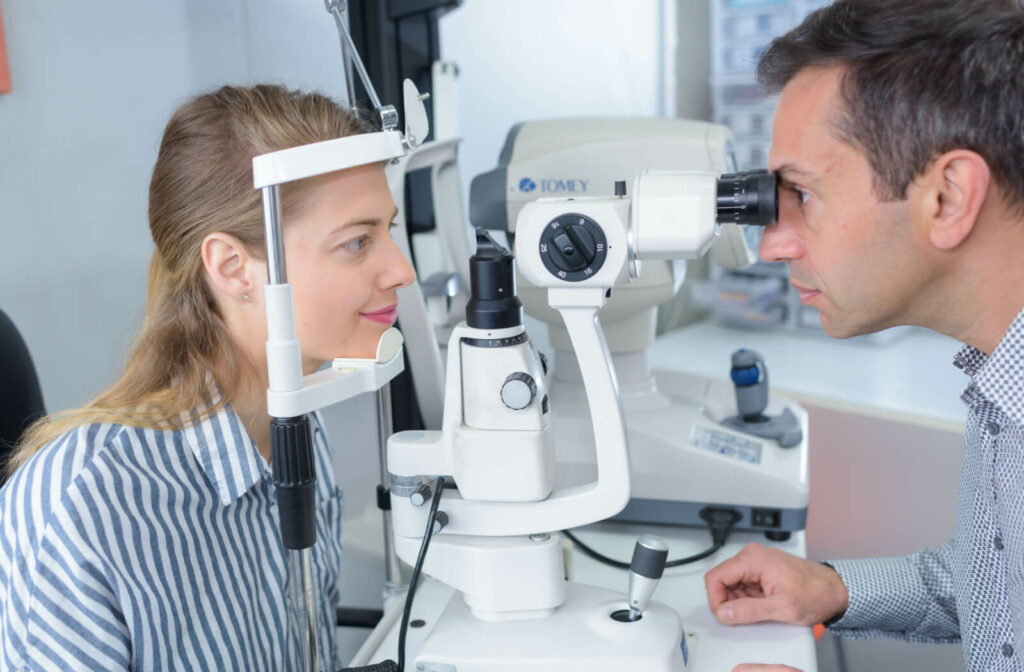Fatigue, weakness, headaches, and dizziness can be signs of low iron levels in your body. Low iron levels in the body lead to iron deficiency anemia.
Similarly to how low iron affects the body, it also affects the eyes. Low iron can cause damage to the retina (the light-sensitive tissue at the back of the eye), and can affect your eyesight.
Blood tests are a sure way to diagnose low iron. However, during an eye exam, your eye doctor can check your eyes for a pale pink or white color.
Why Is Iron Important?
Iron is a mineral that is essential for the production of hemoglobin, the protein in red blood cells. Hemoglobin delivers oxygen from the lungs to the body’s tissues and organs. Without enough iron, your body can’t produce sufficient hemoglobin.
Your body also needs iron for growth and development and to make some hormones. How much iron you need varies based on age, biological sex, and diet.
Low Iron Levels
When iron levels are low, your body will use stored iron from the liver, muscles, spleen, and bone marrow. However, when stored iron levels become low, it can lead to iron-deficiency anemia.
Iron deficiency anemia results in smaller red blood cells that now carry less hemoglobin, which means they have less oxygen transported throughout the body. Symptoms of iron deficiency anemia can include:
- Pale skin color
- Brittle nails
- Cold hands and feet
- Gastrointestinal upset
- Weakness
- Tiredness
- Lack of energy
- Problems with concentration and memory
- Compromised immune system
- Inability to control body temperature
What Causes Low Iron?
Several factors can contribute to low iron levels in the body, including:
- Insufficient Iron Intake: Iron-rich foods include red meat, poultry, seafood, and green leafy vegetables.
- Absorption Problems: Abnormalities in the gastrointestinal tract can lead to malabsorption of iron.
- Blood Loss: Chronic blood loss can also lead to low iron levels, often due to menstruation, gastrointestinal bleeding, or injury.
- Body Changes: Pregnancy and growth spurts in children require increased iron and red blood cell production.
Risk Factors for Low Iron
The following groups of people are more at risk for iron deficiency anemia:
- Biological Women: Menstrual cycles make biological women and teenage girls more susceptible.
- Vegetarians & Vegans: A plant-based diet can lack iron.
- Blood Donors: Regular blood donations can increase your chance of iron deficiency.
- Infants & Children: Premature, low-birth, and babies who don’t get enough iron from breast milk are at higher risk of iron deficiency. Also, children that go through growth spurts may be at risk for low iron levels.
How Low Iron Affects Eyesight
The eyes need oxygen and nutrients to function correctly. A deficiency in iron with insufficient oxygen supplied to the body and the eyes can result in eye problems and affect eyesight.
Anemic Retinopathy
Anemic retinopathy occurs when the body struggles to deliver oxygen to the retina, resulting in retinal hypoxia. Retinal hypoxia can lead to:
- Infarction of the nerve fiber layer
- Vascular dilatation
- Microtraumas to the vessel walls
- Retinal edema
- Retinal hemorrhages
In most cases, symptoms are asymptomatic. Rare symptoms of anemic retinopathy can include impaired vision or cotton wool spots.
Symptoms of anemic retinopathy can vary, but they commonly include blurred vision, difficulty seeing in low light, and changes in color perception. In severe cases, it can lead to vision loss.
Central Retinal Vein Occlusion
Iron deficiency anemia is a known cause of central retinal vein occlusion (CRVO). Low iron causes hypoxia, which leads to injury to the epithelial cells in the retino-choroidal circulation. Signs of CRVO can include hemorrhages, cotton wool spots, and optic disk swelling.
Thin Choroidal Thicknesses
Children with iron deficiency anemia have thinner choroidal thickness than healthy children. The choroid exists between the retina and the sclera (the white part of the eye) and receives the major blood supply to the eye.
It consists of vascular beds that supply the retinal tissues with nutrients and oxygen. Choroidal thinning in childhood is an early sign of ocular blood circulation deterioration.
Early detection and treatment are key to managing vision problems and preserving your vision. If you suspect you may have anemia, visit a healthcare professional to determine the underlying cause. See your eye doctor for an eye exam if you experience changes in your vision.
Low Iron Treatment & Prevention
Treatment options for low iron may include the following:
- Address the underlying cause of anemia
- Manage conditions contributing to anemia
- Increase iron intake
- Blood transfusions
How to Prevent Low Iron
A well-balanced diet rich in iron is essential to prevent low iron levels. Foods rich in iron include:
- Beans
- Red meat
- Dried fruits
- Iron-fortified cereals
- Peas
Foods high in vitamin C can also help improve iron absorption, such as:
- Citrus fruit
- Leafy greens
- Broccoli

Protect Your Vision
Iron is a vital nutrient that can impact the body and eyesight. A well-balanced diet and regular eye exams can help prevent and detect any eye problems early before they affect your vision.
Don’t neglect your eye health, and consult with your doctor if you are experiencing any symptoms of low iron. Or book an appointment with Griffin Optometric Group to monitor your eye health.



